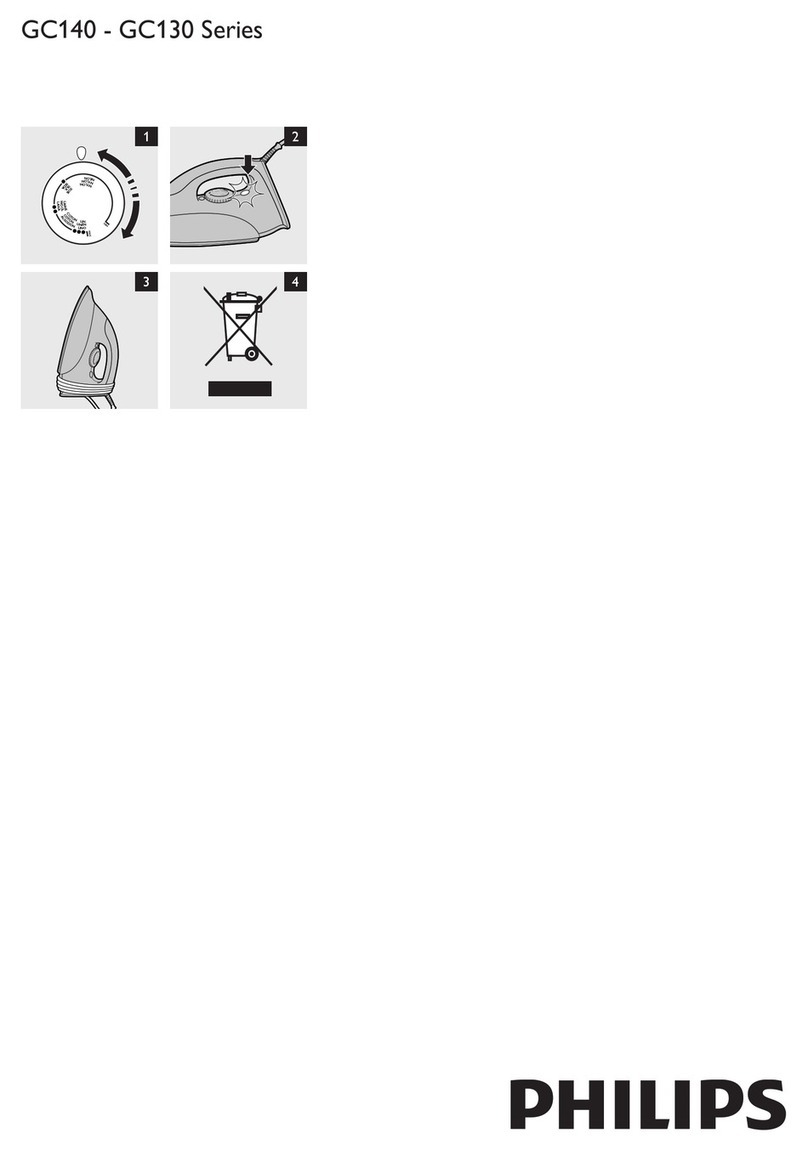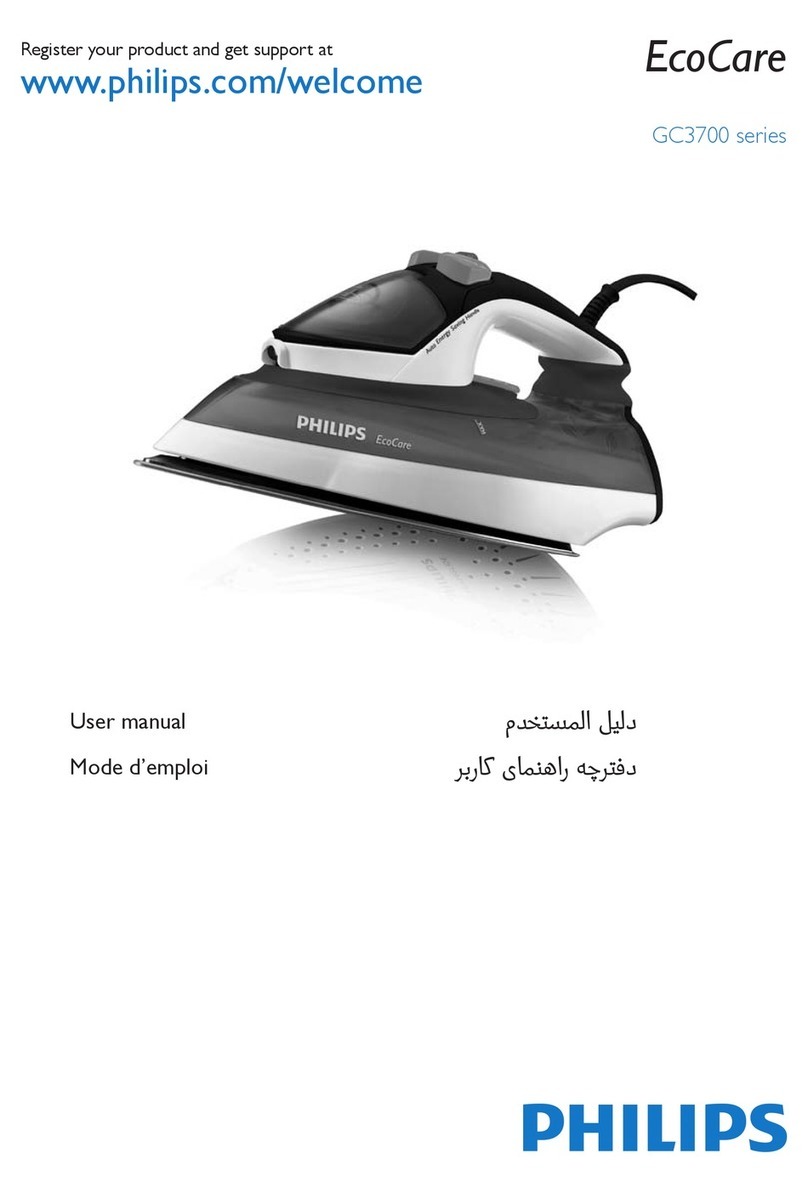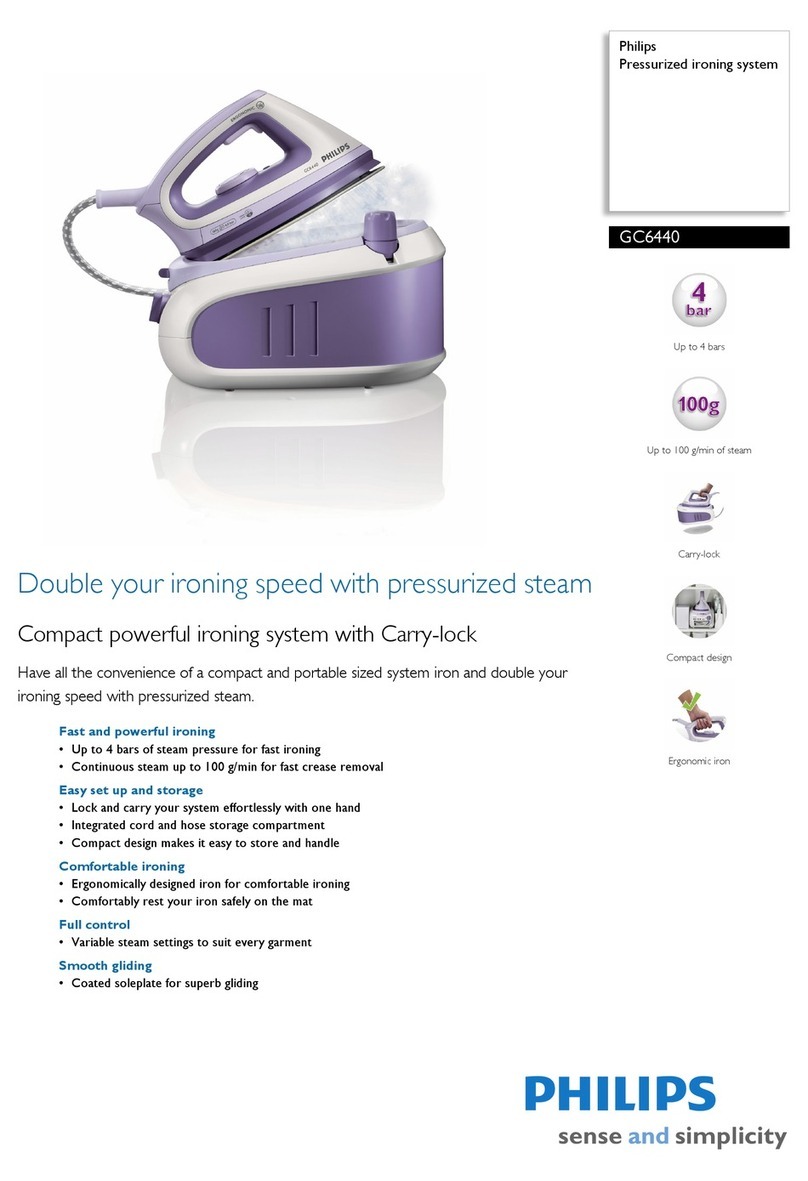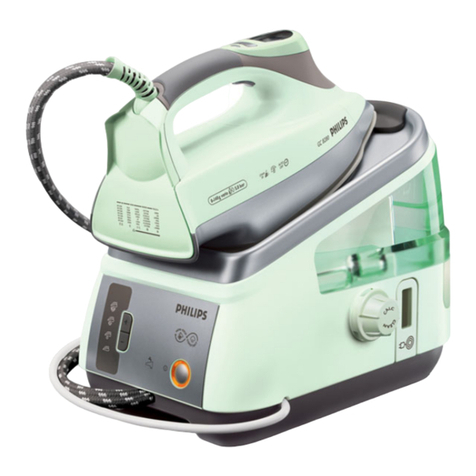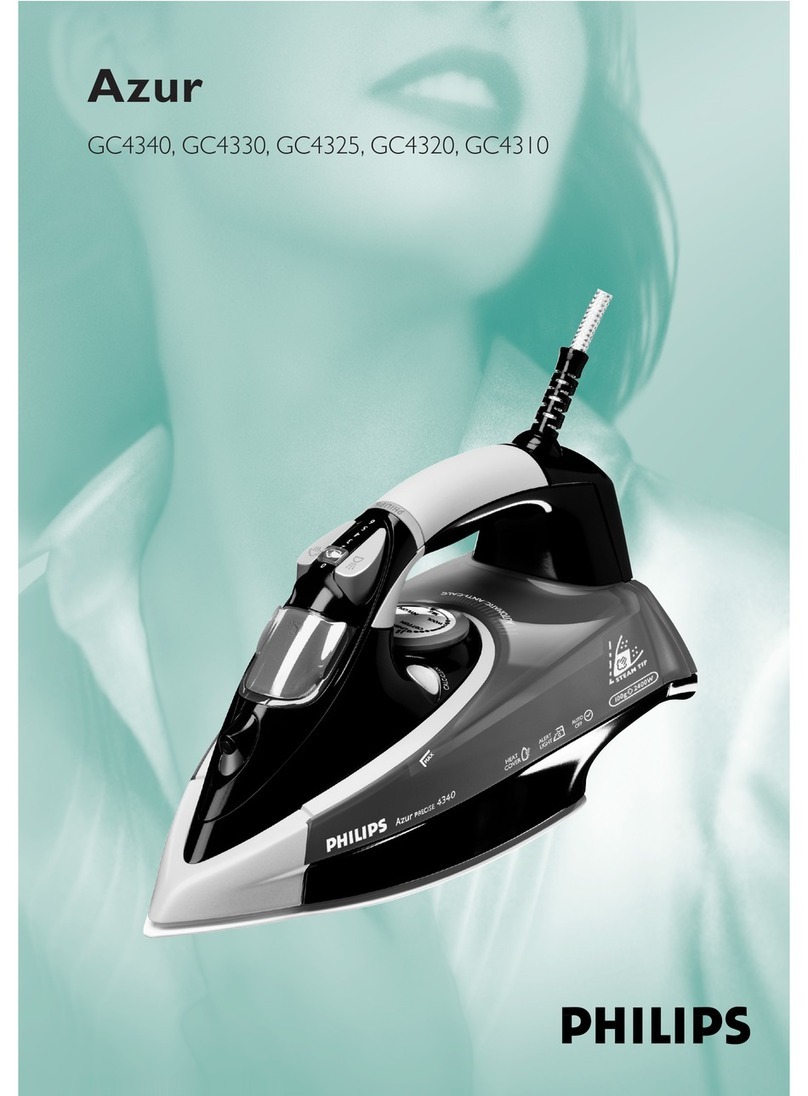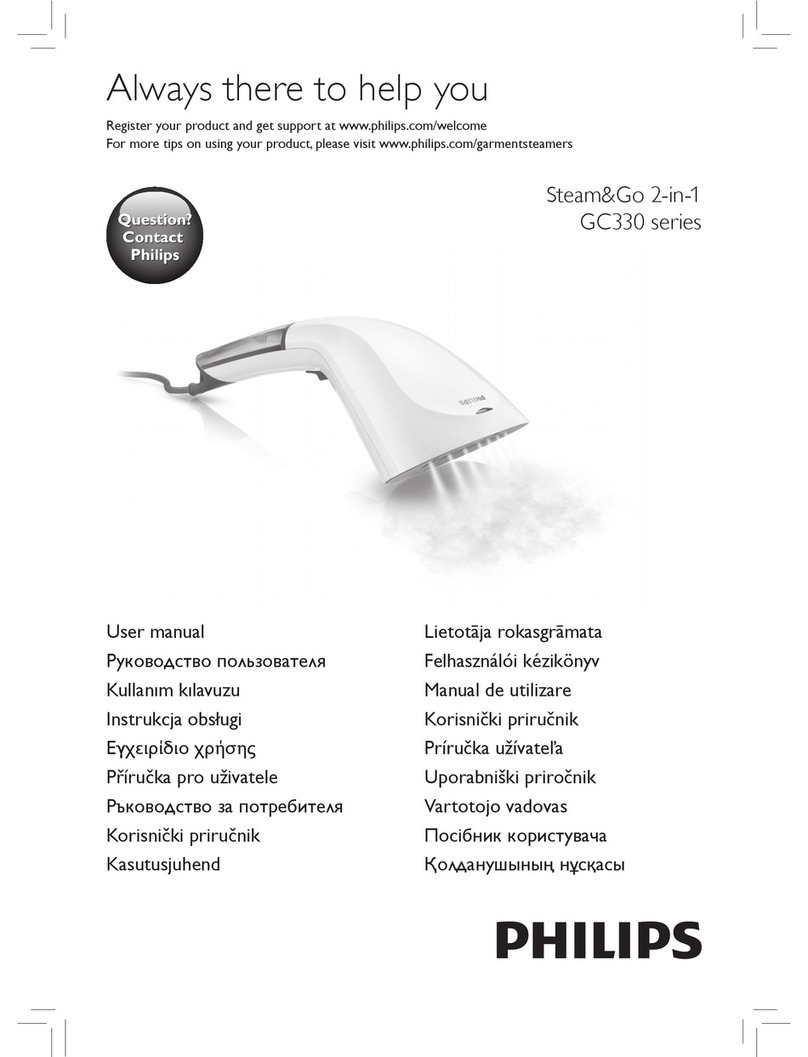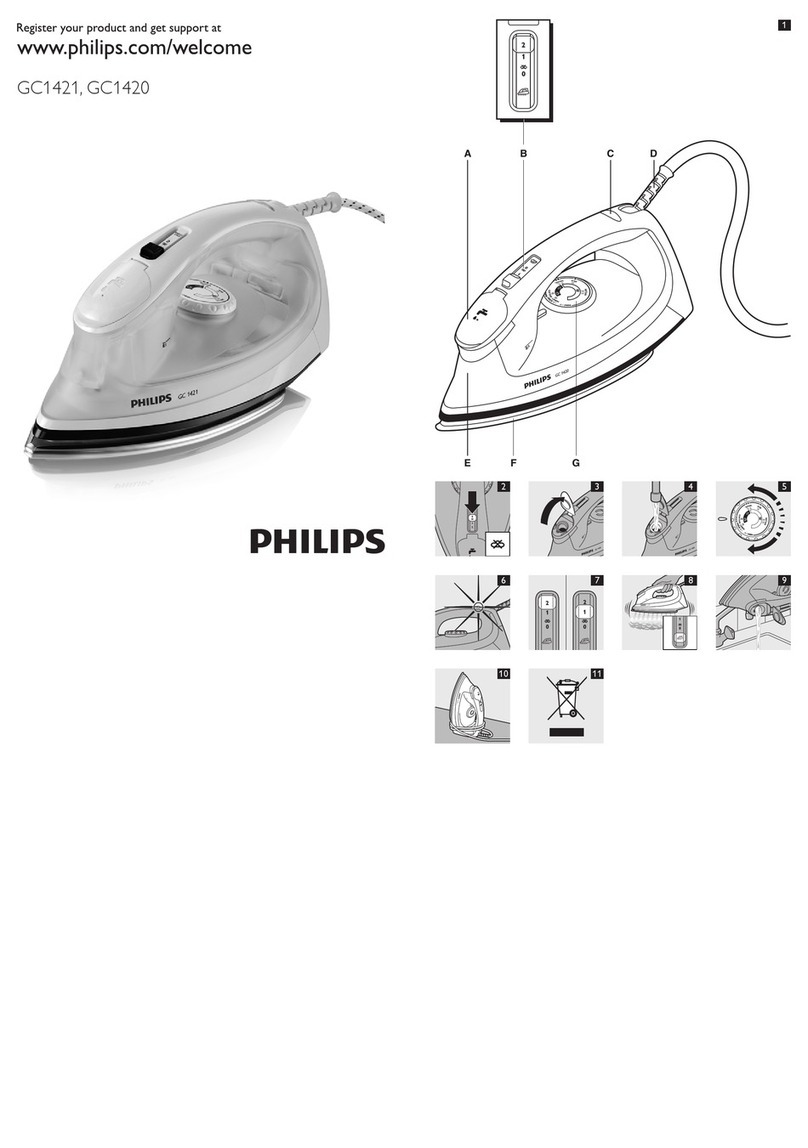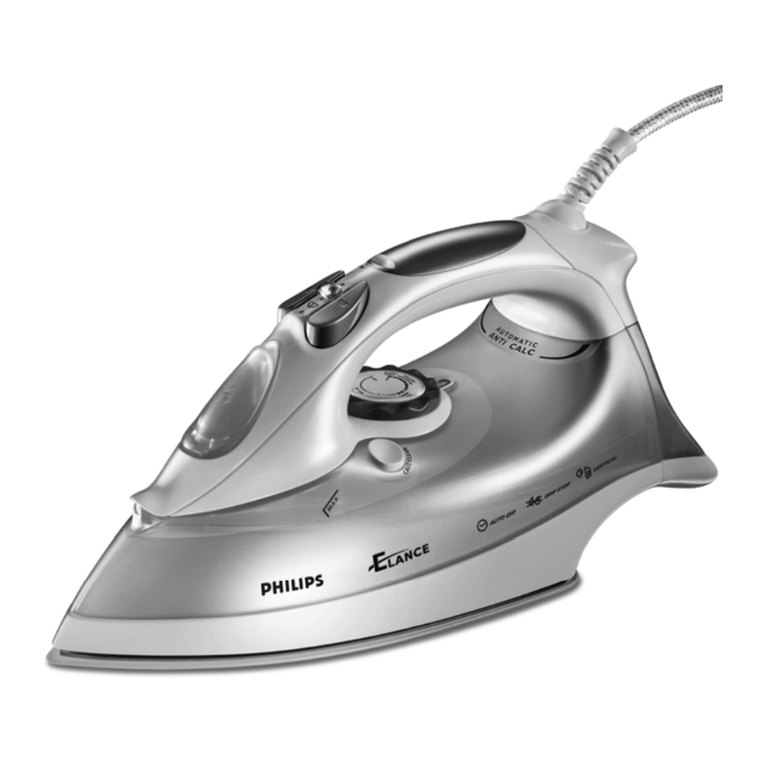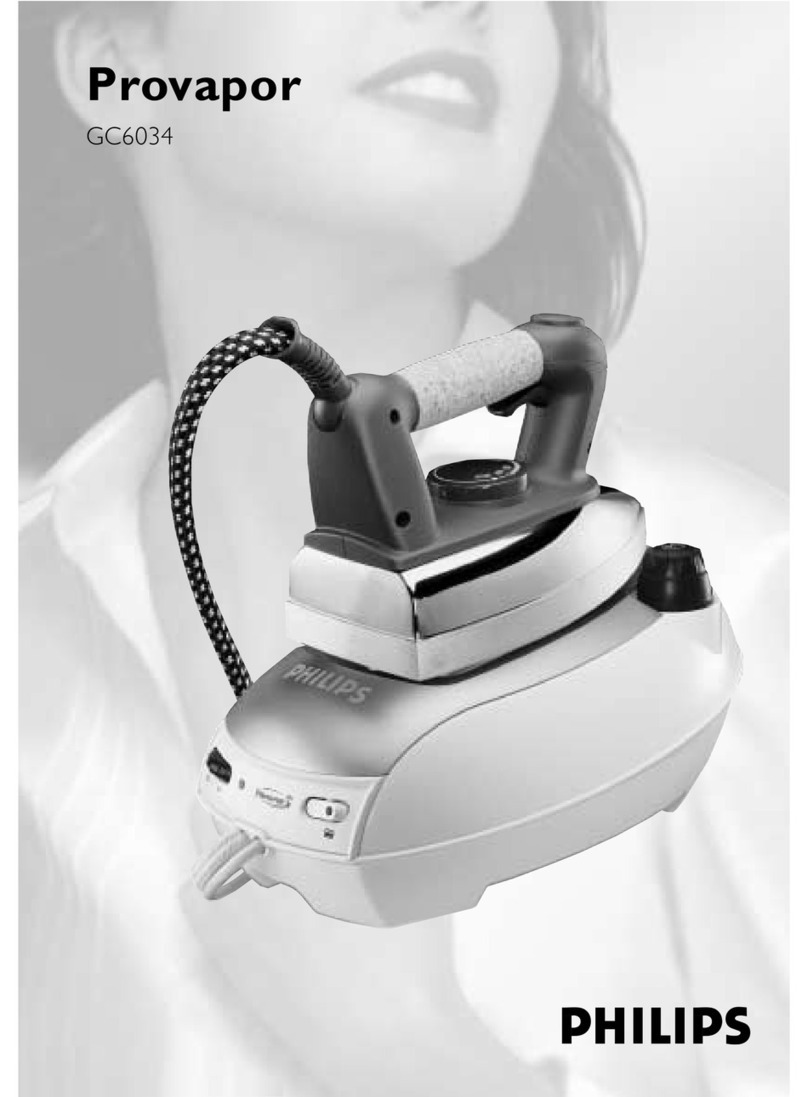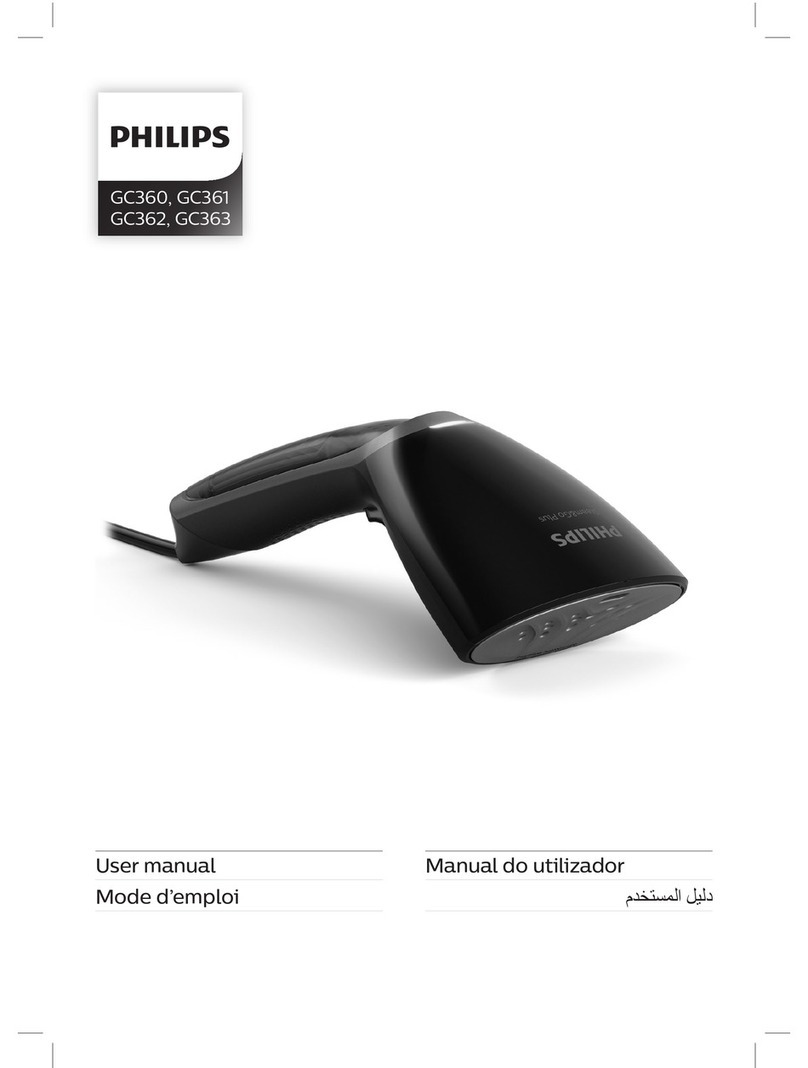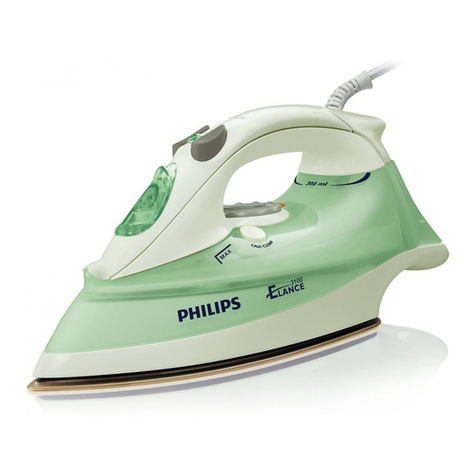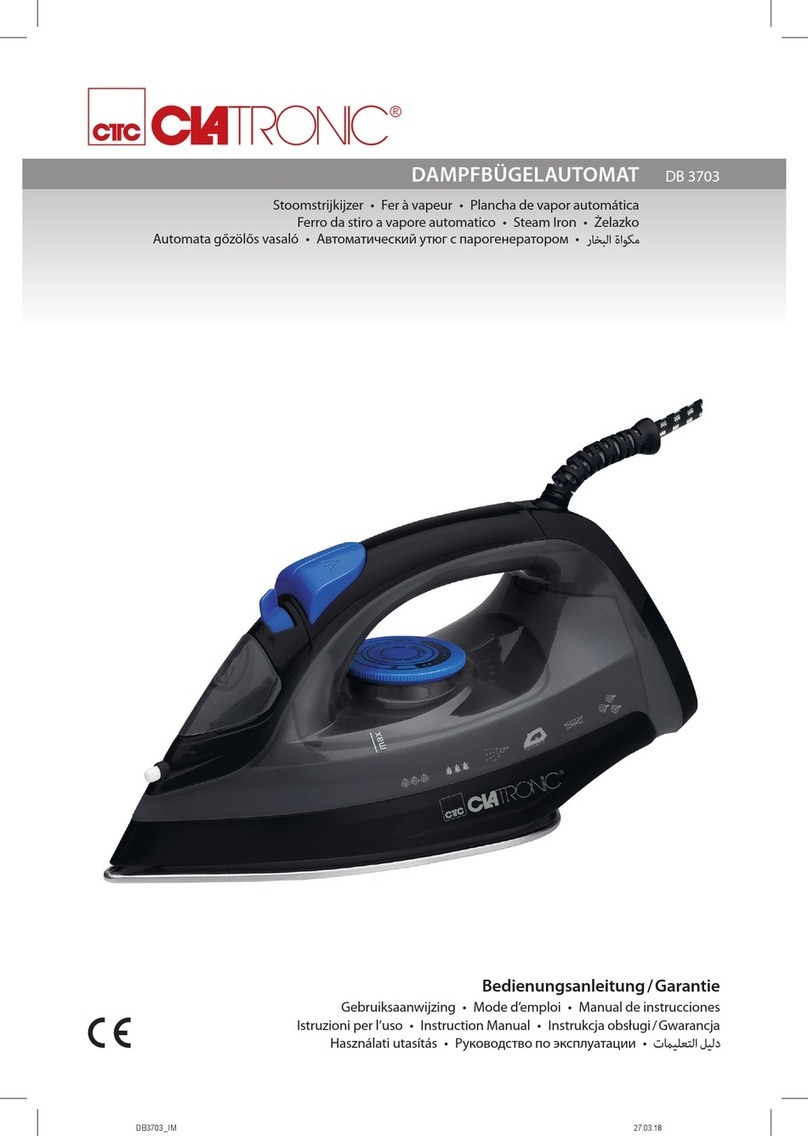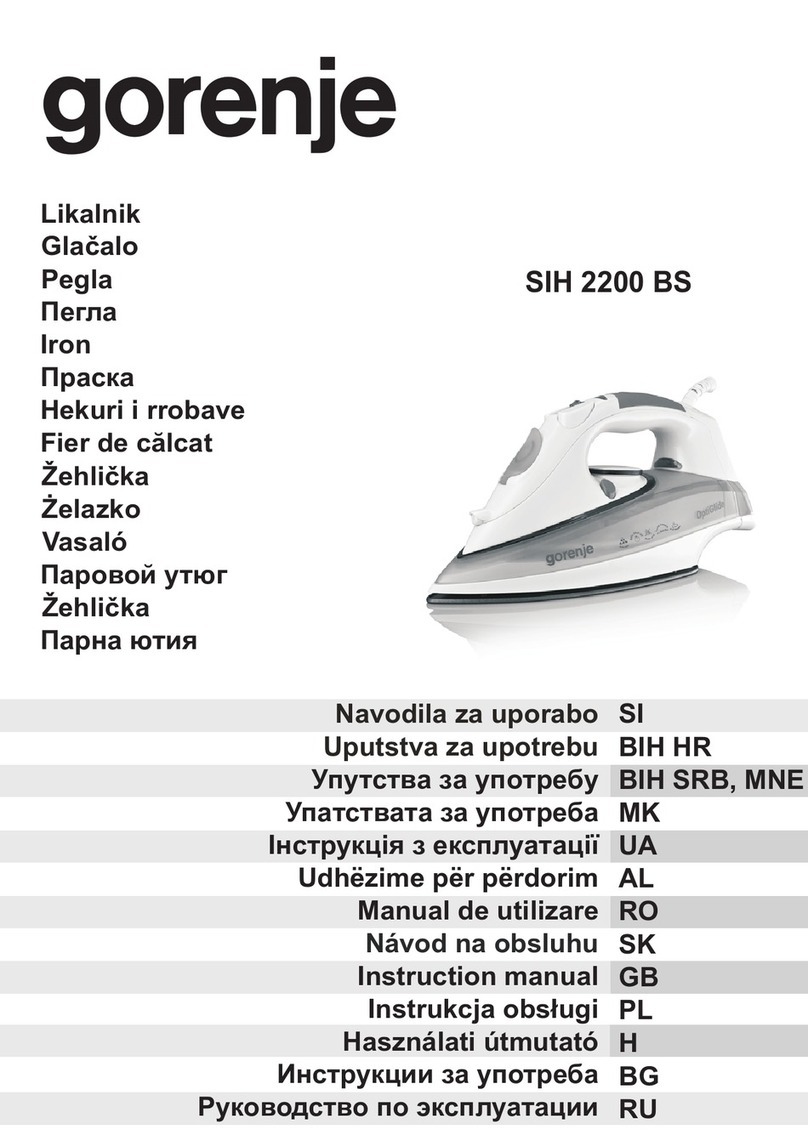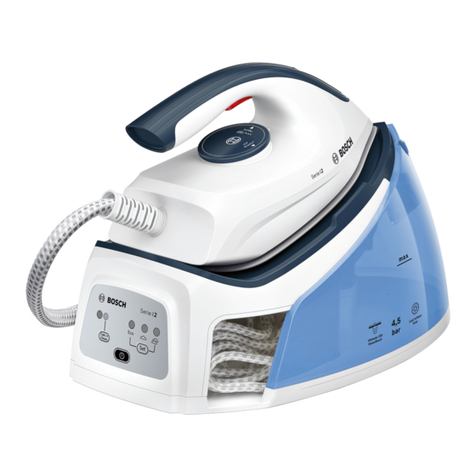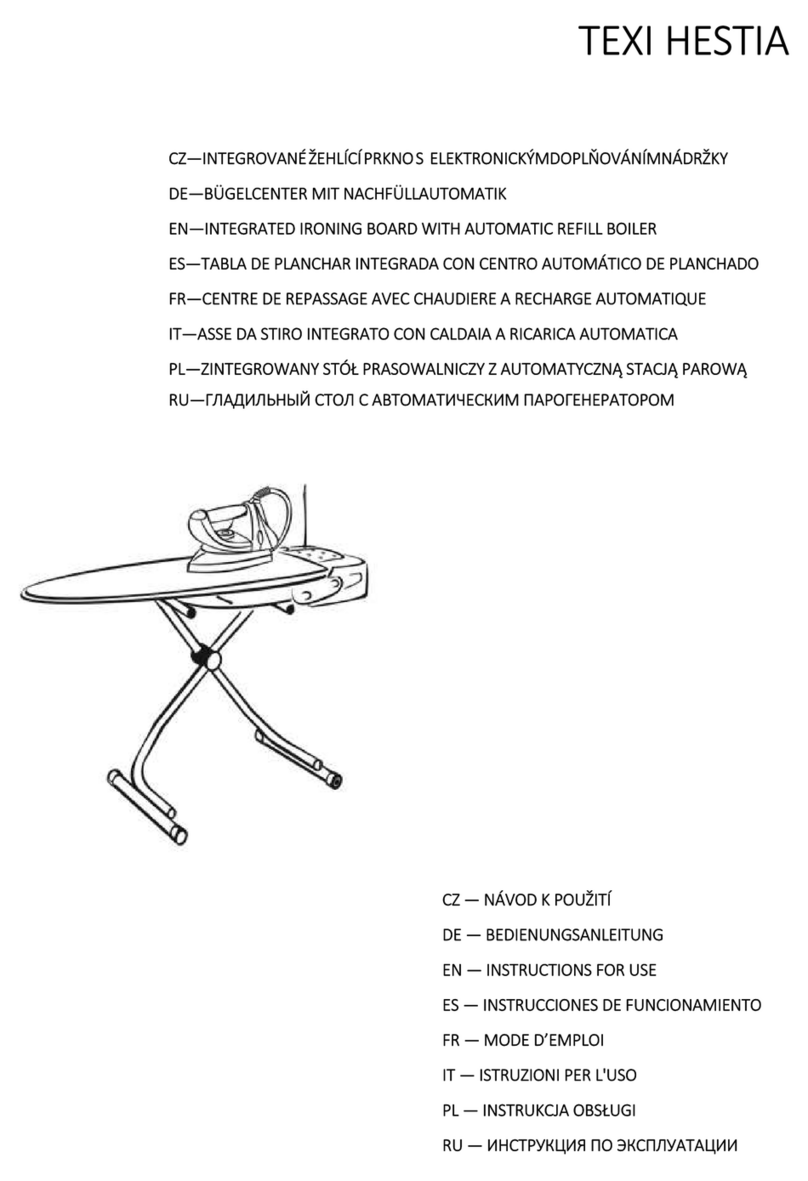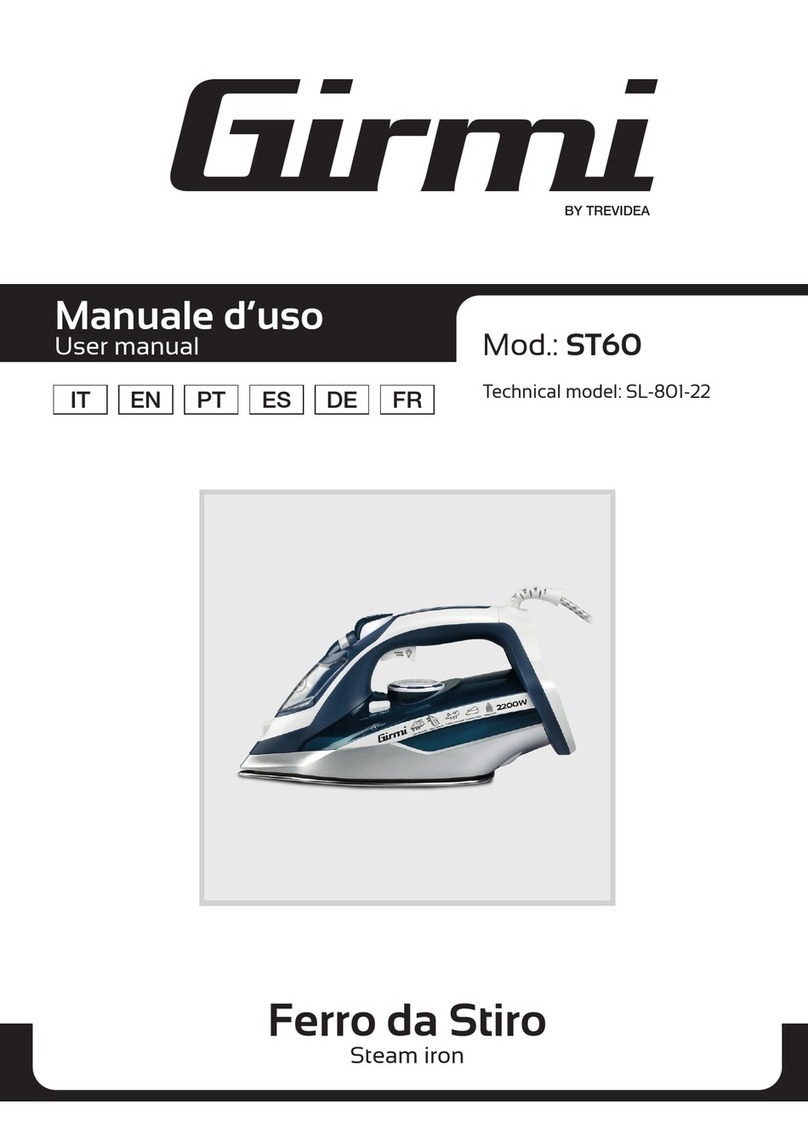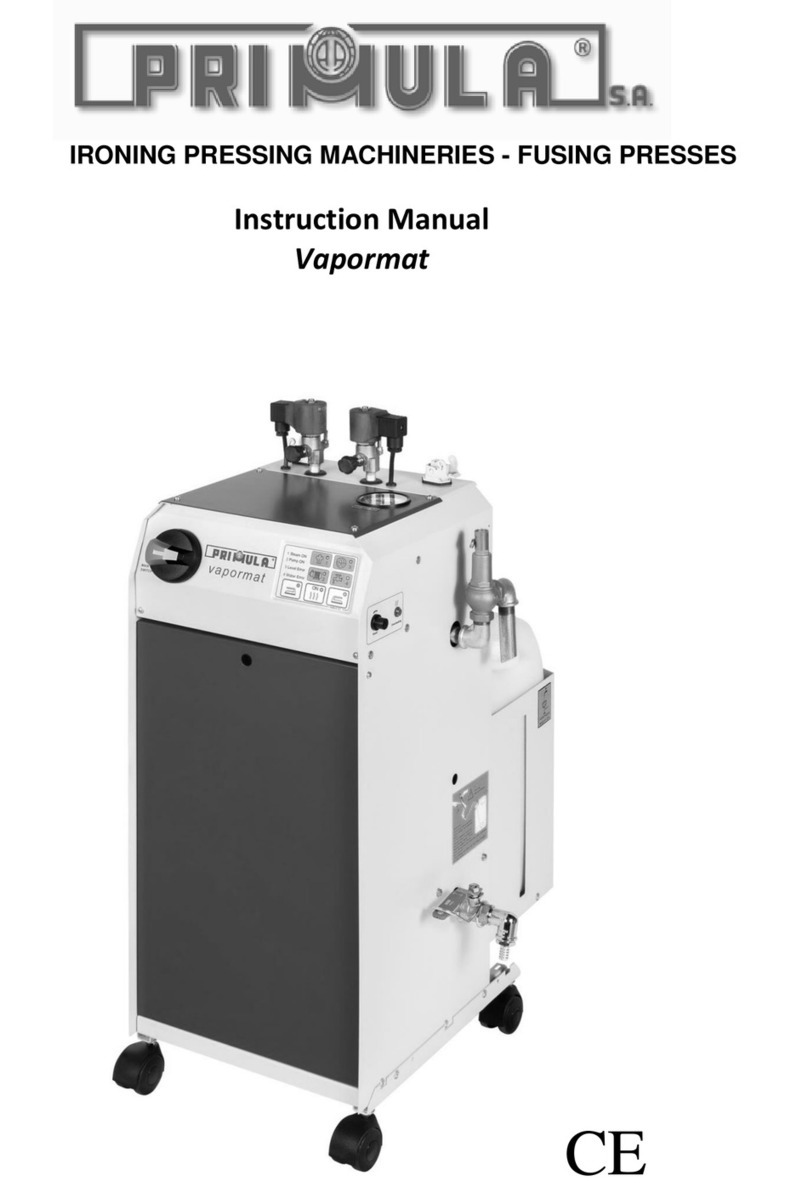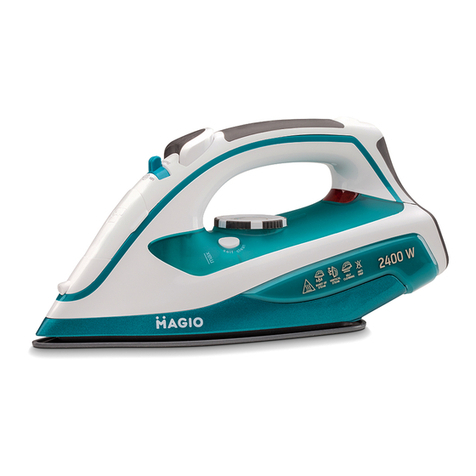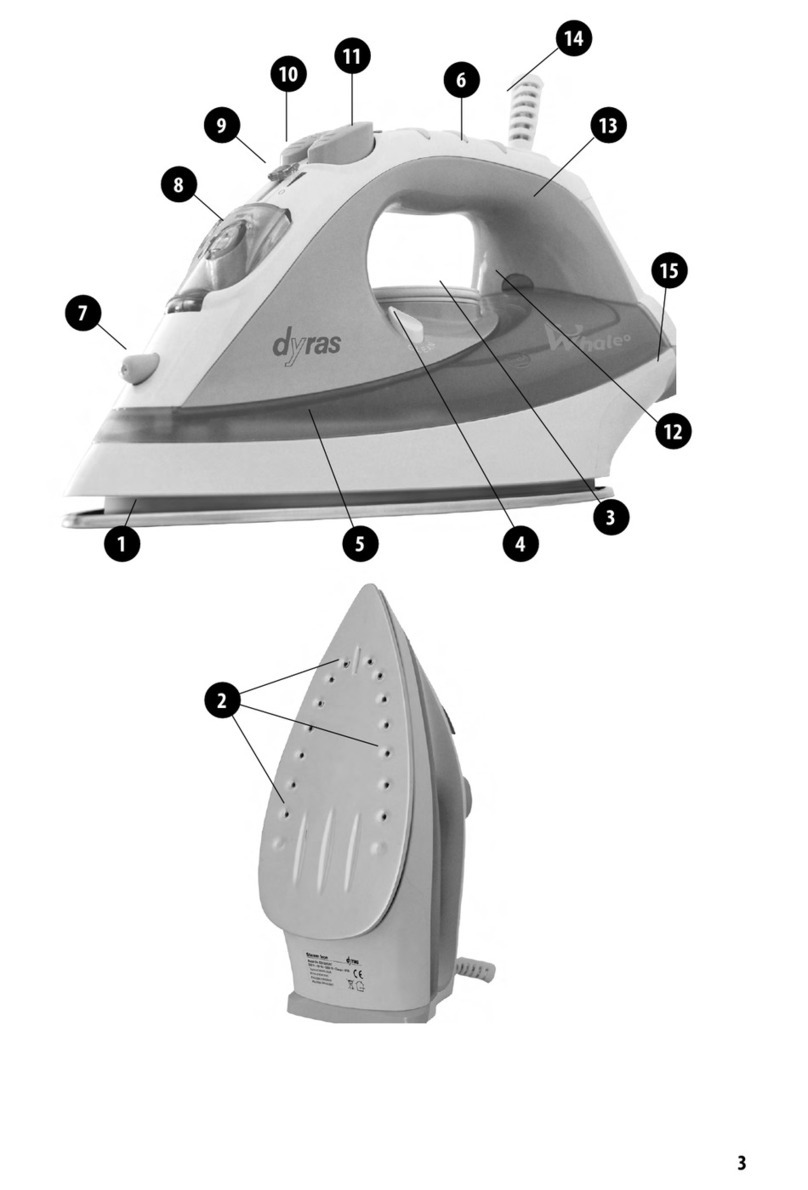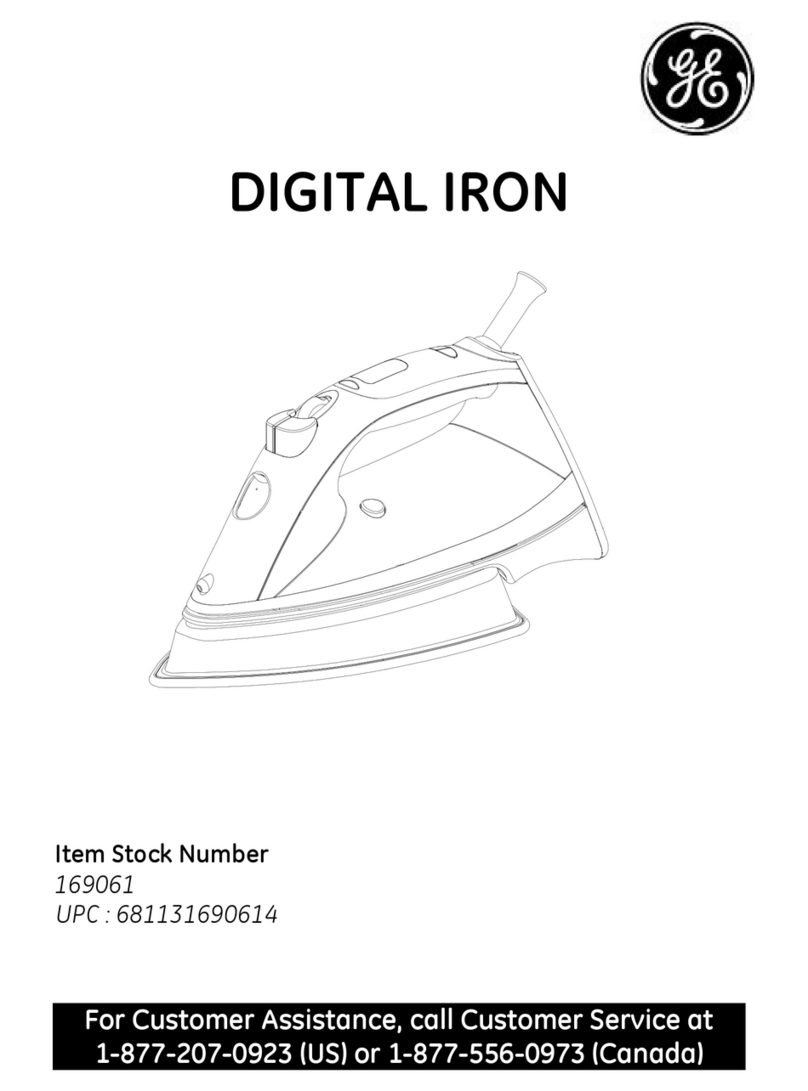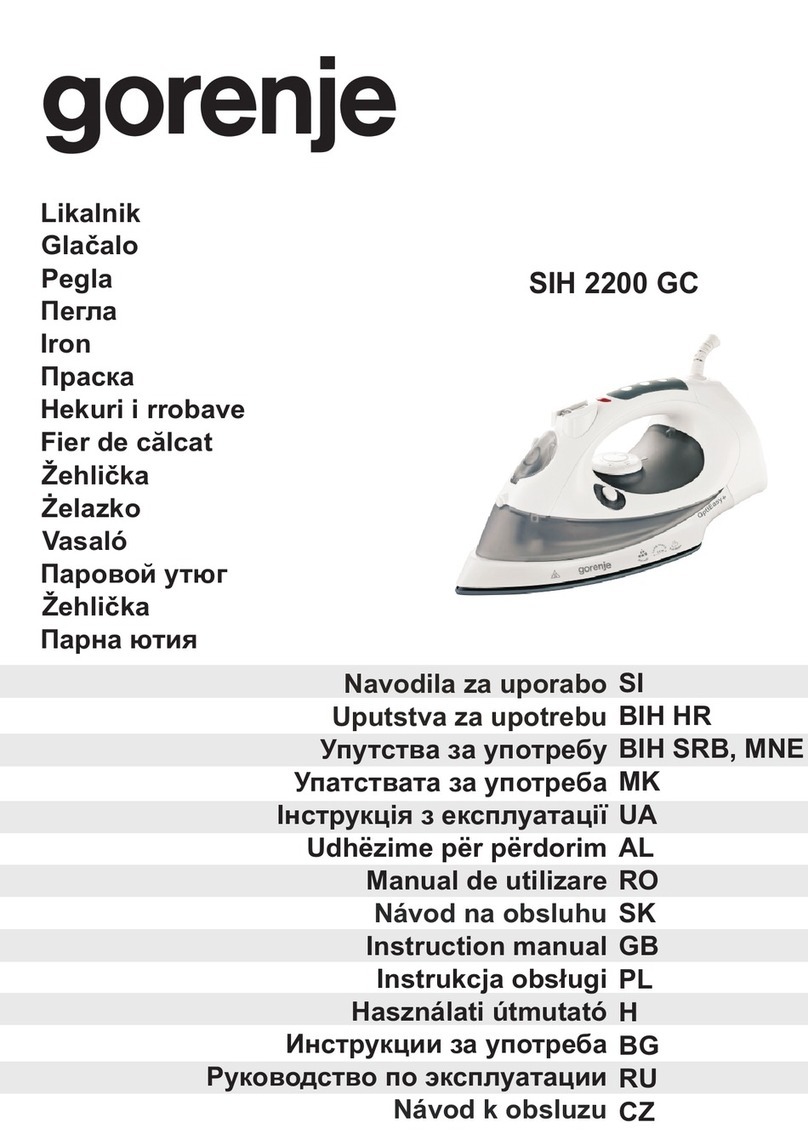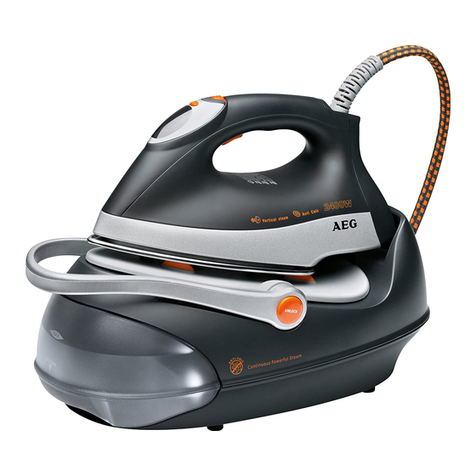FRANÇAIS
Important.
Lisez ces instructions attentivement avant d’utiliser votre fer et conservez-les
pour une consultation ultérieure.
◗Vérifiez que la tension indiquée sur votre fer correspond bien à la
tension de votre secteur avant de brancher l'appareil.
◗Ce fer doit être raccordé à une prise équipée d'une mise à la terre.
◗N'utilisez pas le fer s'il est tombé, si la prise ou le cordon sont
endommagés, ou si le fer lui-même est endommagé ou présente des
fuites.
◗Vérifiez le cordon d'alimentation régulièrement.
◗Si le cordon d'alimentation est endommagé, il ne doit être remplacé
que par un Centre Service Agréé Philips ou par une personne
autorisée pour éviter tout accident.
◗Ne laissez jamais le fer à repasser sans surveillance pendant qu'il est
branché.
◗Ne plongez jamais le fer dans l'eau.
◗Tenez l'appareil hors de portée des enfants.
◗La semelle du fer peut devenir extrêmement chaude et pourrait,en cas
de contact, causer des brûlures.
◗Evitez le contact du cordon d'alimentation avec la semelle lorsqu'elle
est chaude.
◗Lorsque vous avez fini de repasser, pendant que vous nettoyez,
remplissez ou videz le réservoir d'eau, et même si vous laissez le fer
pour un bref instant, réglez la commande de vapeur sur la position O,
placez le fer à repasser sur le talon et débranchez l'appareil.
◗Le fer doit être utilisé et/ou posé sur une surface stable.
◗Si repose fer est fourni avec le fer, assurez-vous qu'il soit placé sur une
surface stable.
◗Cet appareil est destiné à usage domestique uniquement.
Avant la première utilisation.
1Retirez tout auto-collant ou film de protection qui se trouve sur la
semelle (fig. 1).
BLe fer peut fumer légèrement quand on le branche pour la première fois. Cela
cessera après un bref instant.
Préparation à l'emploi.
Remplissage du réservoir
1Assurez-vous que l'appareil est débranché.
2Réglez la commande de vapeur sur la position 0 (pas de vapeur) (fig. 2).
3Ouvrez le bouchon du réservoir.
4Inclinez le fer en arrière et remplissez le réservoir avec de l'eau du
robinet jusqu'au niveau maximum à l'aide du verre de remplissage (fig.3).
Ne remplissez pas le réservoir au-delà de l'indication MAX.
Ne mettez pas de parfum, de vinaigre, d'amidon, de détartrant, d'additifs
pour repassage, de l'eau déminéralisée chimiquement ou d'autres agents
chimiques dans le réservoir d'eau.
5Fermez le bouchon du réservoir ("clic").
Réglage de la température
1Posez le fer à repasser sur son talon et mettez le thermostat sur la
position souhaitée en tournant (fig. 4).
Lisez l'étiquette de l'article à repasser pour régler la température nécessaire
de repassage:
-1Fibres synthétiques (par ex. acrylique, nylon, polyamide, polyester)
-1Soie
-2Laine
-3Coton, lin.
Si vous ne connaissez pas la composition des tissus, repassez en commençant
par la température la plus basse sur une partie interne du vêtement et
invisible de l'extérieur.
La soie, la laine et autres fibres synthétiques: Repassez sur l'envers pour éviter
les taches. N'utilisez pas la fonction spray pour éviter de lustrer les tissus.
Commencez toujours le repassage des ar ticles de fibres synthétiques
nécessitant la température la plus basse.
2Branchez la fiche dans la prise de courant.
3Attendez que le témoin lumineux orange s'éteigne avant de
commencer à repasser (fig. 5).
Le témoin lumineux orange s'allume de temps en temps pendant le repassage.
Utilisation de l'appareil.
Repassage à la vapeur
1Assurez-vous qu'il y a suffisamment d'eau dans le réservoir.
2Sélectionnez la température de repassage conseillée (voir chapitre
"Préparation à l'emploi", section "Réglage de la température").
3Sélectionnez le réglage de vapeur approprié pour la température de
repassage choisie: (fig. 6).
- 1 - 2 vapeur modérée (réglage température: 2à 3)
- 3 - 4 vapeur maximum (réglage température: 3à MAX)
BLa vapeur est prête une fois que la température réglée est atteinte.
BAttention : de l'eau peut sortir par la semelle (voir section "Anti-gouttes") si la
température réglée est trop basse (MIN à 2).
Repassage sans vapeur
1Réglez la commande de vapeur sur la position 0 (pas de vapeur) (fig. 2).
2Sélectionnez la température de repassage conseillée (voir chapitre
"Préparation à l'emploi", section "Réglage de la température").
Caractéristiques.
Fonction spray
Vous pouvez utiliser la fonction spray pour enlever les faux plis difficiles à
éliminer.
1Assurez-vous qu'il y a suffisamment d'eau dans le réservoir.
2Appuyez sur le bouton spray plusieurs fois pour humidifier l'article à
repasser (fig. 7).
Jet de vapeur
Un jet de vapeur puissant est utile pour enlever les faux plis difficiles à
éliminer.
La fonction jet de vapeur peut être utilisée entre les températures 2et MAX.
1Appuyez et relâchez le bouton jet de vapeur (fig.8).
Débit vapeur puissant dégagé par la pointe à vapeur
additionnelle (types GC3260 et GC3240 uniquement)
L'orientation du jet de vapeur très puissant améliore la distribution de la
vapeur pour atteindre les moindres recoins. La fonction jet de vapeur peut
être utilisée entre les températures 2et MAX.
1Appuyez et relâchez le bouton jet de vapeur (fig.9).
Défroissage vertical
1La fonction jet de vapeur peut être également utilisée en tenant le fer
en position verticale (fig. 10).
Il est utile pour enlever les faux plis des vêtements en position verticale,
rideaux, etc.
Ne dirigez jamais le jet de vapeur vers des personnes.
Anti-goutte (modèles GC3260, 3240, 3232, 3231, 3230
uniquement)
Ce fer à repasser est doté d'un système anti-goutte : lorsque la température
de la semelle est trop basse, la production de vapeur est interrompue afin
d'empêcher que la semelle ne goutte trop.Vous entendrez un clic si cela se
produit.
Fonction électronique d'arrêt automatique
(type GC3260 uniquement)
◗Cette fonction arrête automatiquement le fer s'il reste immobile
pendant quelque temps (fig. 5).
◗Le témoin rouge commence à clignoter pour indiquer que le fer a été
arrêté par la fonction de sécurité.
Pour faire chauffer le fer à nouveau: prenez le fer en main ou bougez-le
légèrement. Le témoin rouge arrêt automatique s'éteint.
- Si le témoin de la température s'allume, attendez que celui-ci s'éteigne
avant de commencer à repasser.
- Si le témoin reste éteint vous pouvez commencer le repassage.
Nettoyage et entretien.
Après le repassage
1Débranchez l'appareil et laissez-le refroidir.
2Nettoyez le fer avec un chiffon humide. Essuyez les particules de
calcaire et autres salissures de la semelle avec un détergent (liquide)
non-abrasif.
3Videz le réservoir après le nettoyage (fig. 11).
4Laissez le fer refroidir complètement.Enroulez le cordon
d'alimentation autour du support de rangement et fixez l'extrémité à
l'aide du clip.
5Rangez toujours le fer sur son talon et placez-le sur une surface stable
et sèche (fig. 12).
Système Anti-calcaire Double Active
Le Système Anti-calcaire Double Active garantit une durée de vie plus longue
de l'appareil.
◗La tablette anti-calcaire évite que les particules de calcaire se déposent
sur les orifices de vapeur. La tablette ne doit pas être changée (fig. 13).
◗La fonction auto-nettoyage enlève les particules de calcaire. Utilisez la
fonction auto-nettoyage toutes les deux semaines. Si l'eau de votre
région est très calcaire (par ex: lorsque des particules de calcaire
sortent par la semelle) vous devez utiliser cette fonction plus souvent.
1Assurez-vous que l'appareil est débranché.
2Réglez la commande de vapeur sur la position 0.
3Remplissez le réservoir d'eau jusqu'au niveau maximum.
Ne versez pas de vinaigre ou d'autres agents détartrants dans le réservoir
d'eau.
4Sélectionnez la température de repassage maximum.
5Branchez l'appareil.
6Débranchez le fer quand le témoin lumineux s'éteint.
7Tenez le fer à repasser au-dessus de l'évier, appuyez sur le bouton
d'auto-nettoyage et maintenez-le, et secouez légèrement le fer (fig. 14).
De la vapeur et de l'eau bouillante sortent ainsi par les trous de la semelle en
entraînant avec elles les impuretés.
8Relâchez le bouton Auto-nettoyage dés que le réservoir est vide.
Répétez cette opération aussi souvent que nécessaire.
Après l'auto-nettoyage
- Insérez la fiche dans la prise murale et laissez le fer réchauffer pour sécher
la semelle.
- Débranchez le fer quand le témoin lumineux s'éteint.
- Repassez un vieux morceau de tissu pour vous assurer que la semelle est
bien sèche et propre.
- Avant de ranger l'appareil laissez-le refroidir.
Environnement.
◗Ne jetez pas l'appareil en fin de vie avec les ordures ménagères, mais
déposez-le à un endroit prévu à cet effet par les pouvoirs publics pour
son recyclage.Vous aiderez, ainsi, à protéger l'environnement (fig.15).
Garantie et service.
Pour plus d'informations, visitez notre site Internet : www.philips.com ou
veuillez contacter le Service Consommateurs Philips de votre pays (vous
trouverez le numéro de téléphone dans le dépliant sur la garantie
internationale). S'il n'y a aucun Service Consommateurs Philips dans votre
pays, contactez votre distributeur ou le Service Department of Philips
Domestic Appliances and Personal Care BV.
Dépannage.
Ce chapitre résume les problèmes les plus courants problèmes susceptibles
d'être rencontrés. Lisez les sections suivantes pour plus de détails. Si vous ne
pouvez pas résoudre le problème, contactez le Service Consommateurs
Philips de votre pays.
ITALIANO
Importante.
Per maggior sicurezza, leggere attentamente le istruzioni e osservare le
illustrazioni prima di usare l'apparecchio.
◗Prima di collegare l'apparecchio, controllate che la tensione indicata
sulla placchetta corrisponda a quella della rete locale.
◗Collegate sempre l'apparecchio ad una presa provvista di messa a terra.
◗Non usate l'apparecchio nel caso in cui la spina, il cavo o l'apparecchio
mostrino danni visibili, o nel caso in cui l'apparecchio sia caduto o stia
perdendo.
◗Controllate periodicamente il cavo per evidenziare eventuali danni.
◗Nel caso in cui il cavo di alimentazione fosse danneggiato, dovrà essere
sostituito presso i centri autorizzati Philips, i rivenditori specializzati
oppure da personale opportunamente qualificato, per evitare situazioni
pericolose.
◗Non lasciate mai il ferro incustodito mentre è collegato alla presa di
corrente.
◗Non immergete mai il ferro nell'acqua.
◗Tenete l'apparecchio fuori dalla portata dei bambini.
◗La piastra del ferro può diventare bollente e causare bruciature se
toccata.
◗Fate in modo che il cavo non venga a contatto con la piastra bollente.
◗Quando avete finito di stirare, mentre pulite, riempite o svuotate il
ferro o quando dovete allontanarvi anche solo per un attimo, mettete il
regolatore di vapore in posizione 0 e il ferro in posizione verticale,
quindi togliete la spina dalla presa.
◗Appoggiate il ferro su un asse da stiro o un tavolo stabile.
◗Nel caso l'apparecchio sia provvisto di supporto, controllate che sia
posizionato su una superficie stabile.
◗Questo apparecchio è destinato esclusivamente all'uso domestico.
Prima dell'uso.
1Togliete eventuali adesivi e fogli protettivi dalla piastra (fig.1).
BIl ferro potrebbe emettere un po' di fumo quando viene acceso per la prima
volta. Il fenomeno è del tutto normale e scomparirà nel giro di poco tempo.
Come preparare l'apparecchio per l'uso.
Come riempire il serbatoio
1Controllate che la spina non sia inserita nella presa.
2Mettete il regolatore di vapore in posizione 0 (= niente vapore) (fig. 2).
3Aprite il tappo dell'apertura di riempimento.
4Inclinate il ferro all'indietro e riempite il serbatoio con acqua del
rubinetto fino al livello massimo,usando l'apposito misurino (fig. 3).
Non superate l'indicazione MAX.
Non mettete profumo,aceto, amido, agenti disincrostanti, additivi per ferri
da stiro,acqua decalcificata chimicamente o altre sostanze chimiche nel
serbatoio dell'acqua.
5Chiudete il tappo dell'apertura di riempimento ("click").
Come impostare la temperatura
1Appoggiate il ferro in posizione verticale e impostate la temperatura
richiesta, ruotando il termostato nella posizione più indicata (fig. 4).
Controllate l'etichetta posta sul capo per conoscere la temperatura di
stiratura più indicata:
-1tessuti sintetici (acrilico, nylon, poliammide, poliestere)
-1seta
-2lana
-3cotone, lino
Se non conoscete la composizione di un tessuto, fate una prova su un angolo
del capo che non sia visibile quando viene indossato, in modo da stabilire la
giusta temperatura di stiratura.
Seta, lana e tessuti sintetici: stirate il capo al rovescio per evitare tracce di
lucido. Non usate la funzione spray per evitare macchie. Iniziate a stirare i capi
che richiedono una temperatura più bassa, come ad esempio quelli in fibra
sintetica.
2Inserite la spina in una presa dotata di messa a terra.
3Non appena si spegnerà la spia arancione, aspettate qualche minuto
prima di iniziare a stirare (fig. 5).
La spia gialla della temperatura si accenderà di tanto in tanto durante la
stiratura.
Come usare l'apparecchio.
Stiratura a vapore
1Controllate che ci sia una quantità d'acqua sufficiente nel serbatoio.
2Selezionate la temperatura di stiratura consigliata (vedere il capitolo:
"Come preparare l'apparecchio per l'uso" sezione "Come impostare la
temperatura".
3Selezionate l'impostazione di vapore desiderata. Controllate che
l'impostazione prescelta sia compatibile con la temperatura selezionata:
(fig. 6).
- 1-2 per vapore moderato (impostazione della temperatura da 2a
3)
- 3-4 per massimo vapore (impostazione della temperatura da 3a
MAX).
BIl ferro inizierà ad emettere vapore non appena verrà raggiunta la
temperatura impostata.
BSe la temperatura selezionata è troppo bassa (da MIN a 2) l'acqua
potrebbe fuoriuscire dalla piastra (vedere la sezione "Dispositivo antigoccia").
Stiratura senza vapore.
1Mettete il regolatore di vapore in posizione 0 (= niente vapore) (fig. 2).
2Selezionate la temperatura di stiratura consigliata (vedere il capitolo:
"Come preparare l'apparecchio per l'uso" sezione "Come impostare la
temperatura".
Caratteristiche.
Funzione spray
Potete usare la funzione spray per eliminare le pieghe più ostinate a qualsiasi
temperatura.
1Controllate che ci sia una quantità d'acqua sufficiente nel serbatoio.
2Premete più volte il pulsante spray per inumidire il capo che volete
stirare (fig. 7).
Getto di vapore
Un potente getto di vapore per eliminare le pieghe più ostinate.
Il getto di vapore può essere utilizzato solo a temperature comprese fra 2
e MAX.
1Premete a più riprese il pulsante getto di vapore (fig. 8).
Getto di vapore concentrato dalla speciale BocchettaVapore
(solo mod. GC3260 e GC3240)
Il getto di vapore concentrato e diretto in avanti facilita una miglior
distribuzinoe del vapore in ogni punto del capo da stirare. Il getto di vapore
concentrato può essere usato solo a una temperatura compresa fra 2e
MAX.
1Premete a più riprese il pulsante getto di vapore (fig. 9).
Getto di vapore verticale
1La funzione getto di vapore può essere usata anche tenendo il ferro in
posizione verticale (fig. 10).
Questo getto di vapore è utile per eliminare le pieghe da vestiti appesi, tende,
ecc.
Non puntate mai il getto di vapore verso le persone.
Dispositivo antigoccia
(solo mod. GC3260, 3240, 3232, 3231, 3220)
Il ferro è provvisto di un dispositivo antigoccia che blocca automaticamente
l'erogazione del vapore nel caso la temperatura sia troppo bassa, per evitare
che l'acqua sgoccioli dalla piastra. Quando questo accade, sentirete un bip.
Funzione di spegnimento automatico elettronico
(solo mod. GC3260)
◗La funzione di spegnimento elettronico spegne automaticamente il
ferro se questo viene lasciato immobile per un po' (fig.5).
◗La spia rossa di spegnimento automatico inizia a lampeggiare per
indicare che il ferro è stato spento dalla funzione di spegnimento
automatico.
Per riscaldare nuovamente il ferro, basta sollevarlo o muoverlo leggermente.
La spia rossa si spegnerà.
- Se si accende la spia della temperatura, aspettate prima di iniziare a
stirare.
- Se non si accende la spia della temperatura, il ferro è pronto per l'uso.
Pulizia e manutenzione.
Al termine della stiratura
1Togliete la spina dalla presa e lasciate raffreddare il ferro.
2Pulite l'apparecchio con un panno umido. Eliminate eventuali tracce di
calcare o altri depositi dalla piastra utilizzando un detergente (liquido)
non abrasivo.
3Svuotate il serbatoio dell'acqua dopo la pulizia (fig. 11).
4Lasciare raffreddare il ferro.Avvolgete il cavo attorno all'apposito
supporto e fissatelo con il gancio.
5Riponete sempre il ferro in posizione verticale, in un posto sicuro e
asciutto (fig. 12).
Sistema Anticalcare Double-Active
il sistema anticalcare Double-Active garantisce una maggior durata del vostro
ferro.
◗Le pastiglie anticalcare evitano che il calcare si depositi nei fori del
vapore. Le pastiglie sono costantemente attive e non devono essere
sostituite (fig. 13).
◗La funzione Calc-Clean aiuta a eliminare le particelle di calcare. Usate la
funzione Calc-Clean una volta ogni due settimane. Se l'acqua nella
vostra zona è particolarmente dura (ad esempio quando stirando
fuoriesce del calcare dalla piastra), la funzione Calc-Clean dovrebbe
essere usata più spesso.
1Controllate che la spina non sia inserita nella presa.
2Impostate il controllo vapore in posizione 0.
3Riempite il serbatoio fino al livello MAX.
Non versate aceto o altri agenti disincrostanti nel serbatoio dell'acqua.
4Selezionate la temperatura massima di stiratura.
5Inserite la spina nella presa di corrente.
6Togliete la spina dalla presa di corrente quando la spia si spegne.
7Tenendo il ferro sopra il lavandino, tenete premuto il pulsante
Calc-Clean e scuotete leggermente il ferro (fig.14).
Dalla piastra usciranno acqua bollente e vapore, che trascineranno con sé le
(eventuali) impurità e il calcare.
8Rilasciate il pulsante Calc-Clean non appena l'acqua contenuta nel
serbatoio sarà esaurita.
Ripetete l'operazione nel caso in cui il ferro contenga una grande quantità di
impurità.
Dopo l'operazione di eliminazione del calcare
- Inserite la spina nella presa e riscaldate il ferro in modo che la piastra si
asciughi perfettamente.
- Togliete la spina dalla presa di corrente quando la spia si spegne.
- Passate il ferro sopra uno straccio per eliminare eventuali macchie che si
fossero formate sulla piastra.
- Lasciate raffreddare il ferro prima di riporlo.
Ambiente.
◗A fine vita non gettare questo apparecchio nella normale raccolta dei
rifiuti, ma portalo presso uno dei punti di raccolta autorizzati. In questo
modo contribuirai a preservare l'ambiente (fig. 15).
Garanzia e assistenza.
Se avete bisogno di assistenza o in caso di problemi, vi preghiamo di visitare il
nostro sito web: www.philips.com oppure di contattare il Centro Assistenza
Clienti Philips del vostro Paese (per conoscere il numero di telefono, vedere
l'opuscolo della garanzia). Qualora nel vostro Paese non ci fosse un Centro
Assistenza Clienti, rivolgetevi al rivenditore autorizzato Philips oppure
contattate il Service Departmente of Philips Domestic Appliances and
Personal Care BV.
Localizzazione guasti.
In questo capitolo sono riportati i problemi più comuni che potreste
incontrare con il vostro ferro. Per ulteriori dettagli, vi preghiamo di leggere le
diverse sezioni. Se non riuscite comunque a risolvere il vostro problema,
contattate il Centro Assistenza Clienti del vostro paese.
Solution
Vérifiez le cordon
d'alimentation, la fiche et la
prise de courant.
Réglez le thermostat sur la
position nécessaire.
Remplissez le réservoir
d'eau (voir chapitre
"Préparation à l'emploi").
Réglez la commande de
vapeur sur une position
entre 1 et 4 (voir chapitre
"Utilisation de l'appareil").
Sélectionnez une
température de repassage
appropriée pour le
repassage à la vapeur (2
au MAX). Placez le fer sur
son talon et attendez
jusqu'à ce que le témoin
orange s'éteigne avant de
continuer le repassage.
Continuez à utiliser le fer
en position horizontale et
attendez quelque temps
avant d'utiliser la fonction
jet de vapeur (vertical) à
nouveau.
Sélectionnez une
température de repassage
appropriée pour le
repassage à la vapeur (2
au MAX). Placez le fer sur
son talon et attendez
jusqu'à ce que le témoin
orange s'éteigne avant de
continuer le repassage.
Appuyez le bouchon
jusqu'à ce que vous
entendiez un clic.
Rincez le réservoir d'eau
et n'ajoutez aucun additif.
Réglez le thermostat sur
une température de
repassage appropriée pour
le repassage à la vapeur
(3au MAX). Placez le
fer sur son talon et
attendez jusqu'à ce que le
témoin orange s'éteigne
avant de continuer le
repassage.
Utilisez l'auto-nettoyage
une ou plusieurs fois (voir
chapitre "Nettoyage et
entretien").
Remuez le fer doucement
pour désactiver la fonction
arrêt automatique. Le
témoin lumineux s'éteint.
Videz le réservoir d'eau et
réglez la commande de
vapeur sur la position 0
après utilisation. Rangez le
fer sur le talon.
Cause possible
Il y a un problème de
connexion.
Le thermostat a été réglé
sur MIN.
Il n'y a pas assez d'eau
dans le réservoir d'eau.
La commande de vapeur a
été réglée sur la position 0.
Le fer n'est pas
suffisamment chaud et/ou
la fonction anti-goutte est
activée.
La fonction jet de vapeur
(vertical) a été utilisée trop
souvent.
Le fer à repasser n'est pas
suffisamment chaud.
Le bouchon de l'orifice de
remplissage n'a pas été
correctement fermé.
Vous avez mis un additif
dans le réservoir d'eau.
Le fer à repasser n'est pas
suffisamment chaud.
L'eau est trop dure et
entartre l'intérieur de la
semelle.
La fonction automatique
de sécurité a arrêté
l'appareil (voir chapitre
"Caractéristiques").
Le fer a été mis en position
horizontale tandis que le
réservoir d'eau n'était pas
vide.
Problème
Le fer à repasser est
branché mais la semelle est
froide.
Pas de vapeur.
Pas de jet de vapeur ou
pas de jet de vapeur
vertical.
Des gouttes d'eau
tombent sur le tissu.
Des particules de calcaire
et des impuretés sortent
par la semelle pendant le
repassage.
Le témoin rouge clignote
(type GC3260
uniquement).
Des gouttes d'eau sortent
par la semelle après avoir
refroidi ou rangé le fer à
repasser.
1 2 3 4
5 6 7 8
910 11 12
13 14 15
Soluzione
Controllate il cavo, la presa
e la spina a muro.
Impostate il termostato
sulla posizione richiesta.
Riempite il serbatoio
dell'acqua (vedere il
capitolo "Come preparare
il ferro per l'uso")
Impostate il regolatore
vapore in una posizione
compresa fra 1 e 4
(vedere il capitolo "Come
usare l'apparecchio").
Selezionate una
temperatura che sia adatta
per la stiratura a vapore
(da 2a MAX).
Appoggiate il ferro in
posizione verticale e
aspettate che si spenga la
spia gialla prima di iniziare
a stirare.
Continuate a stirare in
posizione orizzontale e
aspettate un po' prima di
usare nuovamente la
funzione di getto
(verticale).
Selezionate una
temperatura che sia adatta
per la stiratura a vapore
(da 2a MAX).
Appoggiate il ferro in
posizione verticale e
aspettate che si spenga la
spia gialla prima di iniziare
a stirare.
Premete il tappo fino a
sentire un click.
Risciacquate bene il
serbatoio ed evitate di
aggiungere additivi.
Selezionate una
temperatura che sia adatta
per la stiratura a vapore
(da 3a MAX).
Appoggiate il ferro in
posizione verticale e
aspettate che si spenga la
spia gialla.
Usate la funzione Calc-
Clean una o più volte
(vedere il capitolo "Pulizia
e manutenzione")-
Muovete leggermente il
ferro per disattivare la
funzione di spegnimento
automatico. Si spegnerà la
spia.
Svuotate il serbatoio
dell'acqua e impostate il
regolatore di vapore in
posizione 0, dopo l'uso.
RIponete il ferro in
posizione verticale.
Possibile causa
C'è un problema di
connessione.
Il termostato è stato
impostato su MIN,
Non c'è abbastanza acqua
nel serbatoio.
Il regolatore vapore è stato
messo in posizione 0.
Il ferro non è
sufficientemente caldo e/o
è stata attivata la funzione
antigoccia.
Il getto di vapore
(verticale) è stato usato
troppo spesso in un breve
lasso di tempo.
Il ferro non è abbastanza
caldo.
Il tappo dell'apertura di
riempimento non è stato
chiuso bene.
Nel serbatoio dell'acqua è
stato versato un additivo.
Il ferro non è abbastanza
caldo.
L'acqua troppo dura ha
formato del calcare
all'interno della piastra.
La funzione di
spegnimento di sicurezza
ha spento il ferro (vedere il
capitolo "Caratteristiche").
Il ferro è stato messo in
posizione orizzontale con
ancora dell'acqua nel
serbatoio.
Problema
Il ferro è collegato alla presa
di corrente ma la piastra è
fredda.
Non c'è vapore
Il getto di vapore (verticale)
non funziona
Alcune gocce d'acqua sono
cadute sul tessuto.
Dalla piastra fuoriescono
impurità e residui di calcare
durante la stiratura.
La spia rossa lampeggia
(solo GC3260)
L'acqua sgocciola dalla
piastra dopo aver lasciato
raffreddare o dopo aver
riposto il ferro.

